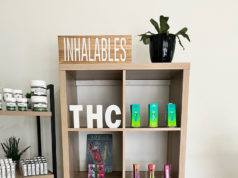Like seemingly every other mainstream media outlet, including The New York Times and CNN, the Star-Telegram continues lurching further to the right to attract more/any subscribers, having run out of left-leaning souls to offend via rightwardly skewed political coverage.
The other day, the daily paper of record devoted seemingly half of its available column inches to just more right-wing appeasement masquerading as in-depth reporting. The piece in question was a typical daily paper-y story about some “classroom to courtroom” pipeline. Readers of this magazine and many, many others may pause because that phrase closely resembles “school-to-prison pipeline,” because that’s what it’s been called for nearly a decade. The Star-T doesn’t care about that. The paper did somersaults to avoid making race the primary focus of “ ‘Broken system’ sends North Texas students with disabilities from classroom to courtroom” when race is the primary focus of any discussion about classrooms and courtrooms. The story ends up a terrific waste of resources and data, and writing, all to avoid upsetting the delicate snowflakes who comprise the North Texas GOP and the Star-T’s precious subscription base. I guess with the recent addition of more conservative columnists to the Star-T staff, we should have all seen this coming.
Before the Karens and Kyles accuse me of “making everything about race!,” my problem is that the Star-T punted on offering a smart, helpful, brave analysis of a serious problem involving race because the higher-ups are clearly afraid of getting into the pelican pose in their offices in front of mean online comments or losing subscriptions from people in Westover Hills, Arlington Heights, and Keller.
First of all, why is the Fort Worth (!) Star-Telegram still referring to North Texas as “Dallas-Fort Worth”? Anyway, the gist of the piece is that some? a couple? many? all? — the story doesn’t say — “Dallas-Fort Worth” schools “push some children who need special education services out of school and into the criminal justice system for perceived misbehavior.”
Knowing the school-to-prison pipeline exists and is real, the next question to pop into the reporter’s head should have been: How many of those pushed kids are poor? And that should have been immediately followed by: How many of those pushed kids are Black or Hispanic?
Since the school-to-prison pipeline is indeed very real and involves race, let’s use the Star-T story as its own data source for the real story they should have published: “Black and Hispanic children, whether they receive special education services or not, are disproportionately criminalized and impacted by the school-to-prison pipeline, said Andrew Hairston, the School-to-Prison Pipeline Project director of Texas Appleseed,” a nonprofit devoted to justice in schools statewide. “A 2012 study by Texas Appleseed found Black students as a whole were 31% more likely [than all others] to receive disciplinary action.”
Well, then, Star-T, how many children ending up in local juvie because they’re not properly diagnosed with a disability are Black?
While the Tarrant County Juvenile Detention Center does not track disabilities for unknown reasons, the Star-T says, “Bennie Medlin, director of Juvenile Services in Tarrant County, estimated about half of the children held at the Tarrant County Juvenile Detention Center” — that ends up being about 1,722 of them — “have some form of mental health or developmental diagnosis.”
Now, since “44% of the juveniles referred to the center [are] Black” — even though Black people account for only 17% of Tarrant County’s total population, according to the most recent U.S. Census data — we can extrapolate that about 758 Black kids in Tarrant County juvie might not have been properly diagnosed.
Now that’s a story that would have represented an even more imperiled demographic, considering that poverty rates are highest among African Americans (18.7%, according to the Census) and that Blacks, and Hispanics, don’t have nearly as many mental health-care options as other groups. For a Black family struggling to get by financially, add a clinically depressed kid or kids who can’t get help anywhere, even at school, and you have a pretty accurate snapshot of our country writ large. Telling their stories, though — like we try to when we can — would force the editors and publishers of mainstream media publications like the Star-T to stop offering coverage that appeals primarily to their wealthy, white subscribers and angry keyboard warriors.
In the Star-T story, the writer hyperlinks part of the sentence “Across the country, children with disabilities are disproportionately incarcerated” to a Teen Vogue piece that’s mostly about the same subject but nationally focused. Even while tightly homing in on disabilities rather than other factors, including race, Teen Vogue cannot write around the reality, saying in only the fourth graf, “The situation is further complicated by disability’s intersections with other identities, which make certain kids more vulnerable than others. Black children are more likely to go through school with untreated disabilities and to be diagnosed with behavioral disabilities that funnel them into what could be called a special-education-to-prison pipeline. [My emphasis.] Children in poverty” — also mostly Black — “are impacted harshly by having a disability, because it’s more difficult for them to access resources outside of those offered by their public school.”
The Teen Vogue writer also tries to write around race but seems to relish in failing, to their credit. In August, the story goes on, a report by the Ruderman Family foundation … found that “nonapparent disabilities” — like the kind we’re talking about here, mostly cognitive rather than physical — “are overrepresented in children already at-risk, including Black, Latinx, and Native kids, those in the foster care system, and trauma survivors.”
The report goes on to say that in addition to “zero tolerance” policies at schools, the at-risk students are “suspended at disproportionately high rates and ultimately criminalized. The result of this systemic discrimination is that over half of our incarcerated population has a mental illness and another 19 to 31% have a nonapparent disability, like cognitive or learning disabilities.”
The worst part is that “conscious and unconscious racial biases” are affecting which students are considered learning disabled, which is a decision ultimately made by teachers, who, in the United States, are mostly white.
“Black students,” Teen Vogue goes on, “are more likely than any of their peers to receive special education services for ‘emotional disturbance,’ ” which does not take into account that, yeah, maybe the Black kids are going through a lot of shit in their homes and neighborhoods. There are actual studies about this question: Are people sad that they’re poor?
Sounds like a job for the Star-Telegram.













The writer of this article not recognizing his white savior racism is perfection.
My kid is Black, asshole.